Wormhole Use Case Analysis: The Most Popular Cross-Chain Communication Protocol in Uniswap Cross-Chain Governance
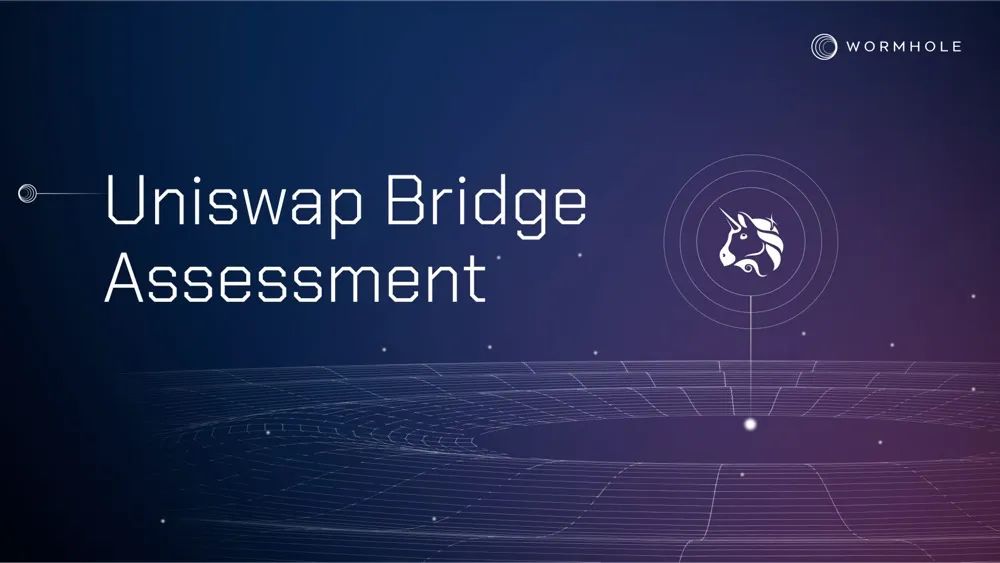
Do you know how many chains Uniswap v3 has been deployed on?
According to Uniswap Governance, as of now, Uniswap v3 has been deployed on 15 chains, including almost all mainstream L1 (EVM compatible) and L2. In the current multi-chain market landscape, there are many similar cases, and more and more applications are becoming multi-chain applications. However, multi-chain deployment often comes with the challenge of how to make efficient and secure governance decisions across different blockchain networks.
To address this issue, Uniswap specifically commissioned a Cross-chain Bridge Assessment Committee composed of individuals with expertise to evaluate several highly requested cross-chain messaging protocols within the community and produce a report. Ultimately, the committee approved Wormhole for all cross-chain deployments of Uniswap.
As the world's largest decentralized exchange (DEX), the technologies and protocols chosen by Uniswap often influence the development trends of the entire blockchain industry. Therefore, this article will delve into why Uniswap chose Wormhole and how Wormhole helps Uniswap achieve its cross-chain governance goals.
Background of the Uniswap Cross-chain Bridge Assessment Report
Before further exploring Uniswap's choice of Wormhole as its preferred cross-chain messaging protocol for governance, it is necessary to briefly understand the background of Uniswap commissioning the Cross-chain Bridge Assessment Committee to build the evaluation framework and produce the assessment report.
At the end of 2022, the Uniswap forum received a proposal to officially deploy Uniswap v3 on the BNB Chain, which sparked extensive discussions about which bridging solution should be used for cross-chain governance use cases. Among numerous posts, community members proposed potential solutions such as Wormhole, Layerzero, Celer, and DeBridge. This discussion was highly technical and also sparked some controversies, with members from different cross-chain bridging solution teams participating in the discussions and directly pointing out the costs and benefits of each proposed solution. Ultimately, the proposal to deploy Uniswap v3 on the BNB Chain was approved, and Wormhole was chosen as the bridging solution to enable the deployment.
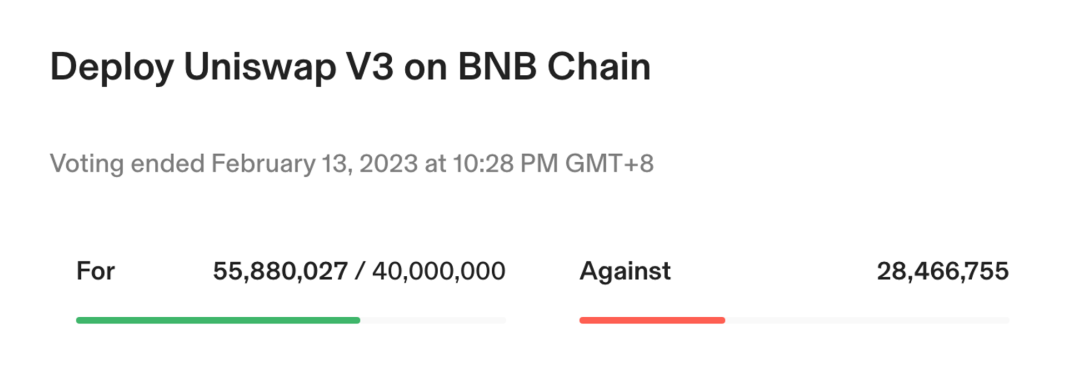
After the voting on the BNB Chain deployment, to better prepare for such decisions for the Uniswap community, the Uniswap Foundation convened the Cross-chain Bridge Assessment Committee and drafted the Uniswap Cross-chain Bridge Assessment Report. The main goals of the committee were:
- To support representatives and community members in making informed decisions related to cross-chain deployment
- To provide a clear process for cross-chain bridge solution providers
- To eliminate inefficiencies in the governance process for all governance stakeholders
Thus, the Uniswap Cross-chain Bridge Assessment Report is a document with clear objectives and a high level of professionalism, reflecting the Uniswap team's rigorous attitude in selecting cross-chain solutions, while also providing guidance for community members when voting on similar proposals in the future.
Reasons for Uniswap's Choice of Wormhole
The Uniswap Cross-chain Bridge Assessment Committee evaluated bridging protocols based on various factors, including security, scalability (the ability to easily scale to new chains deployed by Uniswap), flexibility (the ability to evolve and upgrade over time), and integration work.
Based on these high-level evaluation areas, the committee created a framework to assess six bridges, which included the following four categories of risks:
- Architecture Risk
- Implementation Risk
- Operational Risk
- Network Risks
The committee then adopted a two-step process to complete their assessment and recommendations. First, they evaluated the core attributes, design choices, and security assumptions of each protocol and completed a high-level review of its implementation and operational practices. Protocols that met the relevant standards in the first phase would proceed to the second phase. In the second phase, a rigorous assessment of all four categories of risks was completed, including an analysis of the source code and on-chain and off-chain data.
Ultimately, through the committee's in-depth research and collaboration with various cross-chain communication protocol teams, the committee concluded that both Wormhole and Axelar showed sufficient promise to be used by the Uniswap DAO for cross-chain governance. Among them, Wormhole was approved for all cross-chain deployments, with ongoing monitoring of any changes that may affect its core security model; Axelar received conditional approval, requiring re-evaluation after updates to its multi-signature governance.
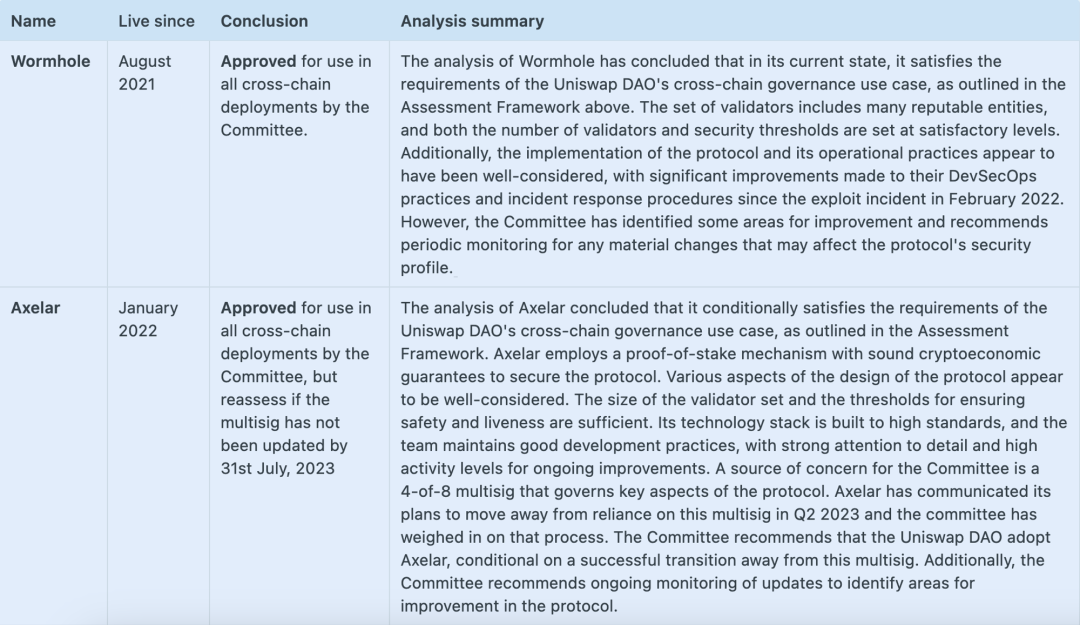
Here is the analysis summary derived from the committee's evaluation:
The analysis of Wormhole concludes that it meets the requirements outlined in the Uniswap DAO cross-chain governance use case within the assessment framework. The validator set includes many reputable entities, and both the number of validators and the security threshold are set at satisfactory levels. Furthermore, the implementation and operational security practices of the protocol have been thoroughly considered, and significant improvements have been made to their DevSecOps practices and incident response procedures since the vulnerability incident in February 2022. The committee has identified several areas for improvement and recommended regular monitoring of any significant changes that may affect the protocol's security status.
From the above conclusions, we can derive some obvious reasons why Uniswap ultimately chose Wormhole. Combining the full content of the report, we summarize the main reasons for its choice of Wormhole:
1. Community Support and Recognition
After the Uniswap forum received the proposal to deploy Uniswap v3 on the BNB Chain, community members proposed several cross-chain communication protocols as potential options. After extensive discussion and voting within the community, Wormhole was ultimately selected as the governance bridge for Uniswap on the BNB Chain. Additionally, Wormhole has also received support in several subsequent Uniswap v3 deployment proposals, reflecting the community's high trust and support for Wormhole.
Here is an overview of the cross-chain communication protocols chosen among the chains where Uniswap v3 has been deployed so far:
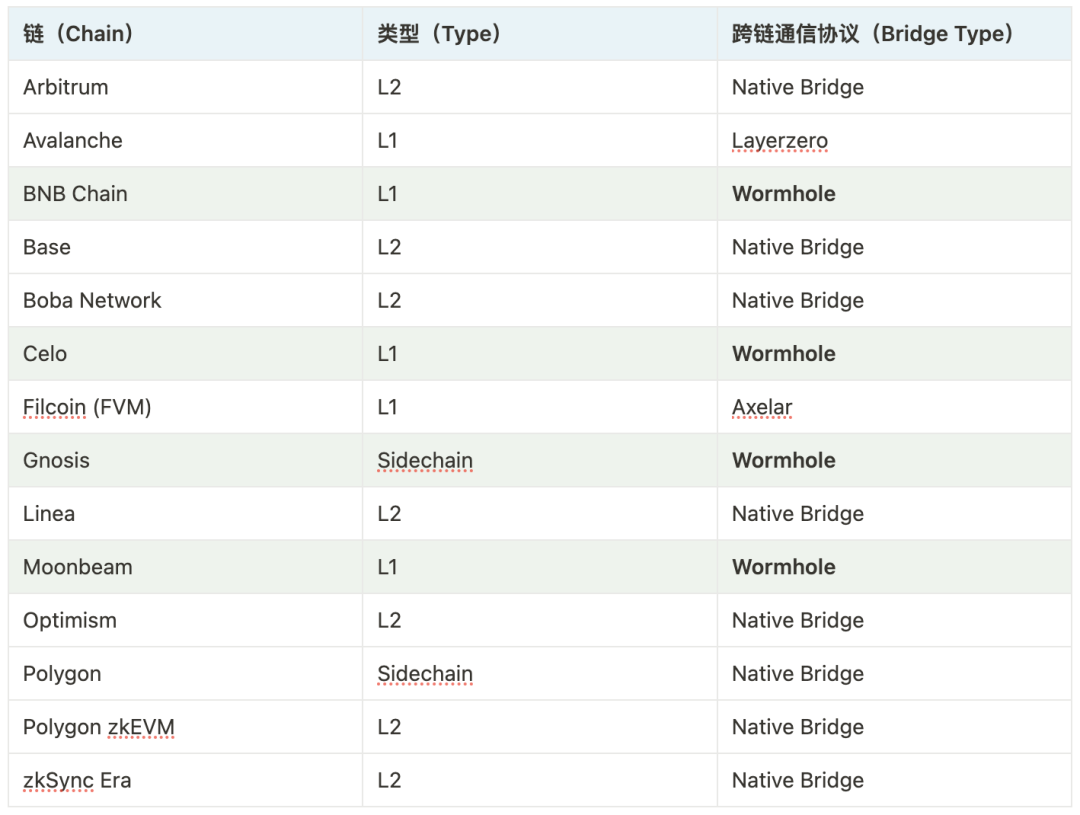
From the table above, it can be seen that, apart from L2, which primarily uses native bridges for cross-chain messaging, Wormhole is currently the most popular cross-chain communication protocol in Uniswap's cross-chain governance.
2. Security and Stability
Wormhole's design and architecture emphasize security and stability, which are crucial for a large project like Uniswap. Uniswap needs to ensure that its cross-chain governance decisions can be safely and accurately communicated to the target chain, and Wormhole provides such assurance. The committee's security assessment concluded that Wormhole's internal design is well thought out and adheres to best practices. Overall, their observations indicate that the codebase is mature. They also made several other observations regarding Wormhole's robust security practices, including:
- Numerous reputable security firms have audited various aspects of the system. All published audits indicate that any high or critical severity issues have been resolved.
- Strong testing has been conducted on core components and the entire system.
- An active Bug Bounty program, with rewards up to $2.5 million (capped at 10% of the affected value).
- Sufficiently detailed and informative technical documentation.
- Clearly defined development and deployment practices.
3. Efficient Cross-chain Communication
Wormhole can provide fast, real-time cross-chain messaging, which is very important for Uniswap's governance decisions. Any delays or interruptions could affect Uniswap's governance effectiveness and user experience.
4. Flexibility and Scalability
Wormhole not only supports existing mainstream blockchain networks but also has good scalability, allowing it to easily support future new chains. This provides Uniswap with more options and possibilities for cross-chain governance.
5. Alignment with Uniswap's Technology and Philosophy
Wormhole's design philosophy and technical architecture align well with Uniswap's decentralized philosophy and technical needs, enabling better collaboration to achieve cross-chain governance goals.
In summary, Uniswap's choice of Wormhole as its core protocol for cross-chain governance is based on Wormhole's technical advantages, community support, and alignment with Uniswap. This choice not only reflects Uniswap's high trust in Wormhole but also provides a successful cross-chain governance use case for the entire blockchain industry.
Practical Application of Wormhole in Uniswap
Cross-chain governance, as one of the core functions of Uniswap in the context of multi-chain deployment, will directly impact Uniswap's overall operation and user experience. So how does Wormhole, as the most popular cross-chain communication protocol in Uniswap's cross-chain governance, specifically operate?
Before that, let's first understand how Uniswap's governance and cross-chain governance work.
The governance of the Uniswap protocol by Uniswap DAO is managed through a fork of Compound's Governor Bravo contract, which allows UNI token holders on the mainnet (Ethereum) to propose and execute function calls using the proposal → voting → queue → execution model.
The governance process begins with community proposals, followed by iterations and a round of off-chain voting, and then submitted on-chain for final voting and execution. If a proposal passes the final on-chain vote, it will be queued in a timelock contract, where the proposed changes can be executed after a 2-day delay. After the 2-day delay, any Ethereum account with sufficient funds to pay for the transaction can call the relevant execution function. This delay is intended to give stakeholders who disagree with the changes enough time to opt out of the protocol.
The following diagram illustrates the on-chain part of the proposal, which changes the protocol-level parameters of the Uniswap v3 deployment on Ethereum.
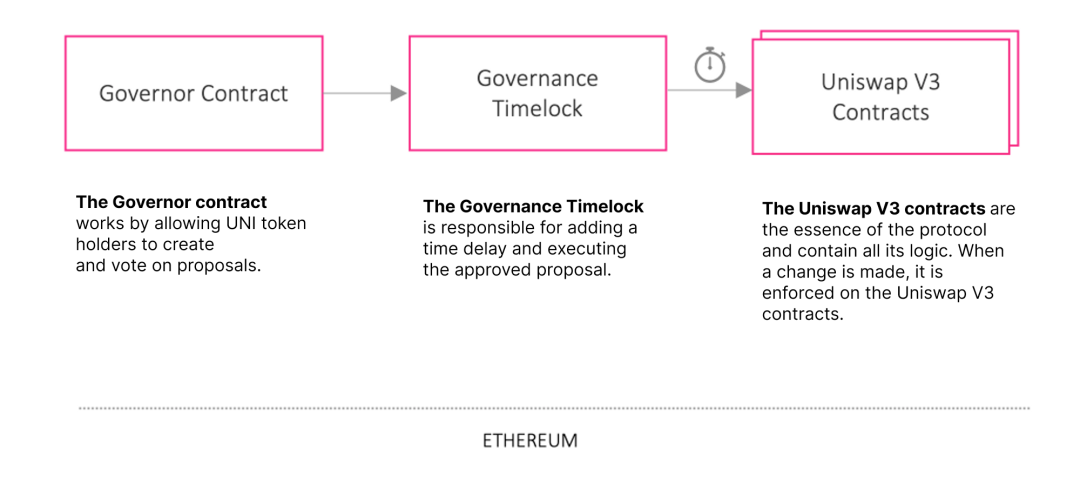
The main functional requirement of the Uniswap DAO cross-chain governance use case is the ability to send governance messages from Ethereum to the remote chain where Uniswap v3 is deployed for execution. Since the Uniswap protocol deployments on other blockchain networks do not have their own governance contracts but are governed through standard processes on the Ethereum network, this means that any proposed updates to the Uniswap protocol deployment on the remote chain must first go through the governance process of the Uniswap DAO on Ethereum. If approved, the decision will be communicated to the remote chain for execution via a messaging bridge. The following diagram summarizes this process:

In this use case, Wormhole acts as the Cross-chain Protocol role in the diagram, responsible for transmitting governance decisions from the mainnet (Ethereum) to the target chain for execution. For L2, its corresponding native bridge serves this role. Similarly, for other applications using Wormhole as a cross-chain messaging protocol, a similar workflow is followed, depending on how the governance module of the application is designed.
Conclusion and Outlook
As one of the most successful DeFi projects, Uniswap has followed best practices in selecting cross-chain communication protocols, commissioning the Uniswap Cross-chain Bridge Assessment Committee to conduct in-depth research and investigation on the protocols currently in high demand in the market that may meet its needs, and providing detailed reports with professional recommendations for community members.
Ultimately, after the committee's comprehensive evaluation, Wormhole was officially approved for all cross-chain deployments. This means that Wormhole is one of the few cross-chain communication protocols in the market that meets the requirements described in the Uniswap DAO cross-chain governance use case within the committee's assessment framework. This approval was made after a thorough analysis of Wormhole's architecture, implementation, operational, and network risks, with the report also detailing Wormhole's robust security measures, mature codebase, and excellent scalability.
However, it is worth noting that the Uniswap Cross-chain Bridge Assessment Committee also proposed several improvement suggestions for Wormhole, including promoting further decentralization of the validator set, defining clear validator assessment metrics, addressing latency issues, and implementing mechanisms within the protocol to address validator passivity issues. According to Wormhole contributors, they have taken these suggestions seriously and are incorporating them into their future development roadmap, aiming to provide a top-notch interoperability platform for Builders.
Finally, the successful collaboration between Wormhole and Uniswap provides a successful example for Web3, demonstrating the immense potential and value of cross-chain communication technology. We look forward to seeing more innovations and breakthroughs in related fields in the future.











